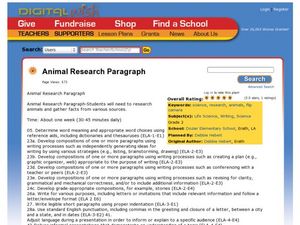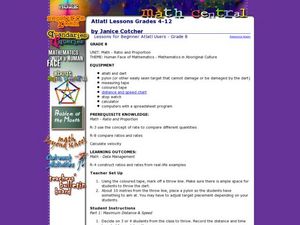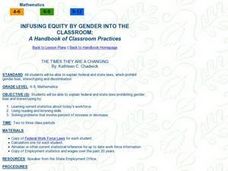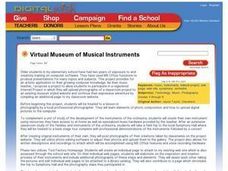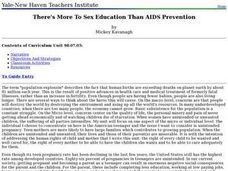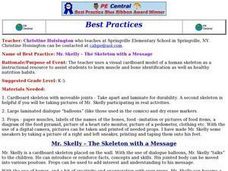Curated OER
3A is Going Batty
Students share their knowledge of bats. In this video production lesson, students use Internet and print resources to research information regarding bats. Students prepare bat questions and answers, record them on video, and produce bat...
Curated OER
Why Data
Students investigate and discuss why data is important. In this statistics instructional activity, students collect, graph and analyze data. They apply the concept of data and lines to finding the rate of change of the line created by...
Curated OER
Human Ecology: How it Relates to Population
Ninth graders are introduced to the concept of population. In groups, they research the problems associated with overpopulation and underpopulation. They practice calculating birth and death rates and discus how they can be used to...
Curated OER
Animal Research Paragraph
Students investigate animals. For this animal research lesson, students choose an animal to research online and record facts from at least 3 types of resources. Students complete a webbing tool, write a paragraph, and use MS word or...
Curated OER
Float the Boat
Students collect data and analyze it using a graph. In this algebra lesson, students identify different bodies of water and relate the flowing to math. They collect data on the rate of flow and the height of flow. They analyze the data...
Curated OER
Mapping Population Changes In The United States
Students create a choropleth map to illustrate the population growth rate of the United States. They explore how to construct a choropleth map, and discuss the impact of population changes for the future.
Curated OER
All About Ratios
Students investigate the use of multiplication and division of whole numbers to solve problems including equivalent ratios and rates.
Curated OER
Circulatory System Design
Students identify the different parts of the circulatory system and their function. They work together to create their own model of the system and use it to determine the rate of blood flow. They answer questions related to their model.
Curated OER
Atlatl Lessons Grade 4-12
Students experiment with velocity, ratios, and rates. In this data management instructional activity, students throw a dart with and without using an atlatl and collect and record various data. Students construct ratios based on the data...
Curated OER
Architecture of the Skeleton
Students experiment with skeletons. In this bone health lesson, students analyze, construct, and perform comparative investigations with bones. They make inferences about the structure and function of various bones. This lesson includes...
Curated OER
Developing Soundproofing Materials
Eighth graders investigate the acoustic properties of materials in order to develop soundproofing products. In this soundproofing lesson students research different resources, design and perform experiments and fabricate, test and...
Curated OER
Gender Equity in the Classroom
Students review employment statistics and wages over the past 20 years. They examine the Federal Work Force Laws. They apply formulas to find the rate of change in the minimum wage.
Curated OER
Pollution Solutions
Students visit a local park to test the quality of the aquatic environments. They search for sources of pollution and examples of pollution control. Based on their obeservations and experiments, they rate their local environment.
Curated OER
Exponential Growth
Pupils study exponential functions. In this exponential growth lesson, students conduct a simulation in which a population grows at random but predictable rate. Pupils compare and contrast linear and exponential functions. Students also...
Curated OER
Wheel of...Geology!
Students participate in a group review activity in order to prepare for an exam. Students study together in their teams prior to the review activity. During the game, the teacher spins a wheel with subject categories written on it and...
Curated OER
Virtual Museum of Musical Instruments
Students incorporate elements of photo composition and demonstrate how to upload digital pictures to the computer. They create their own instrument utilizing resources from home as well as specialized music hardware. They participate in...
Curated OER
See the Wind
Learners explore alternative energy sources. In this wind energy lesson, students will investigate the difference in the speed and smoothness of wind at different altitudes above earth. Learners will use kites, helium balloons,...
Curated OER
Financial Planning For Catastrophe
Students explore the concept of financial planning for a catastrophe. In this financial planning lesson, students discuss the devastation that Hurricane Katrina wrought on the Gulf Coast. Students create budgets to plan for a...
Curated OER
Friendly Flowers
Students listen to music while creating flowers with a partner. They decide on a philanthropic act related to flowers. They recognize the difference between private property and common resources. They use a problem-solving model to...
Curated OER
There's More To Sex Education Than AIDS Prevention
Students are introduced to the views on sexuality in the United States. In groups, they research data from five countries and compare them with the United States. Using the information, they develop reasons why the teenage pregnancy...
Curated OER
Health: The Skeleton with a Message
Young scholars identify human muscles and bones from a cardboard skeleton, named "Mr. Skelly." Using dialog balloons as props, the teacher holds up advice from Mr. Skelly, such as noting he drinks milk to keep his bones strong. The...
Curated OER
Race the Track! Jump the Gap
Students record data of using a track system with variables and how those variables affect a ball used in the track. In this track lesson plan, students design their own track in groups, test the ball's rates of speed, and record their...
Curated OER
Bag Lunch
Students rate foods as safe or unsafe and follow rules for food safety to make them safer.
Curated OER
Kinetic Theory
Students describe how molecules of the different phases of matter move according to the Kinetic Theory. In this chemistry lesson, students observe and participate in teacher demos. They give real world applications of the kinetic theory.





